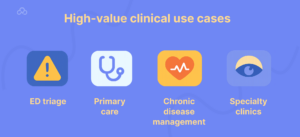Introduction

Hospitals don’t need another widget; they need faster, safer decisions at the bedside. AI in healthcare chatbots can help when they’re embedded into clinical workflows and tied to real data. The best AI diagnostic tools act as assistive systems: they triage symptoms, surface differentials, pull guideline-concordant recommendations, and keep the clinician firmly in control. This isn’t “replace the doctor.” It’s AI in diagnostics that reduces cognitive load, standardizes documentation, and shortens the path from symptoms to solutions. In short: disciplined clinical AI plus sound governance.
What real-time diagnosis looks like with chatbots
AI in healthcare chatbots sit where conversations already happen: intake, triage, and the moment a clinician is piecing together a case. Connected to EHR data and device readings, they:
1. Ask structured follow-ups (onset, character, associated symptoms) and transform free text into coded concepts.
2. Generate a differential list using AI diagnostic tools with priors tuned to prevalence and patient factors.
3. Retrieve guideline snippets (with citations) and highlight “red-flag” paths for escalation.
4. Draft a note or order set that the clinician reviews and edits, AI in medicine as a copilot, not an autopilot.
After deploying a triage chatbot, time-to-first-assessment dropped for chest-pain complaints; clinicians reported fewer missed follow-ups on atypical symptom clusters. The clinical AI didn’t diagnose; it made sure the right questions were asked, every time.
High-value clinical use cases

1. ED triage: Chatbots gather structured history, calculate risk scores (e.g., HEART-style logic), and page the right team. AI in diagnostics helps reorder the queue without skipping the physician exam.
2. Primary care: For complex multi-symptom visits, AI diagnostic tools keep a running differential, check drug interactions, and draft patient-friendly explanations in plain language.
3. Chronic disease management: In AI in healthcare, symptom checkers tied to remote monitoring (BP, pulse ox) flag decompensation early; the chatbot schedules labs and tees up a clinician review.
4. Specialty clinics: Ophthalmology and dermatology pair chatbots with image intake (lesion photos, fundus shots). The bot handles consent, quality tips (“please retake in brighter light”), and structured symptom capture before the consult, clinical AI doing the boring parts well.
No-show rates stayed flat, but “time with doctor spent on assessment” rose because documentation happened beforehand. Net effect: more attention on the exam, less on the keyboard. That’s the quiet win AI in medicine can deliver.
How the stack actually works
A typical AI in healthcare chatbot stack looks like this:
1. Interface layer: web, mobile, or patient portal; clinician-side lives inside EHR in a SMART on FHIR panel.
2. Reasoning layer: LLM or hybrid model orchestrator with guardrails; calls out to AI diagnostic tools (symptom encoders, risk calculators, drug databases).
3. Retrieval layer: secure access to EHR (FHIR), guidelines, order sets, and device data.
4. Audit & safety layer: prompt templates, restricted vocab, red-flag lexicons, PHI logging, and human-in-the-loop checkpoints, core to clinical AI safety.
Where errors arise: incomplete context, outdated guidelines, poor calibration for rare conditions, and unbounded generation. Good systems respond with retrieval grounding, version-pinned content, thresholded recommendations (“consider,” not “must”), and explicit uncertainty.
Safety, governance, compliance (non-negotiable)
AI in healthcare should be run like SaMD: hazard analysis, mitigations, and post-market surveillance. A few habits that keep teams out of trouble:
1. Not vibes, but guardrails. Retrieval-grounded responses with citations, restricted templates, and lists of prohibited phrases.
2. Humans are in command. Sign-off on orders, instructions, and differentials is required. Always.
3. Keep an eye on the drift. Track alert burden, subgroup performance, and calibration. Pin versions and re-validate.
4. PHI discipline. Least-privilege scopes, encryption, full audit trails.
5. Change control. Stage model/prompt/guideline updates (silent → limited → general) with explicit rollback criteria.
Ops note: A prompt tweak once over-weighted a risk factor in older diabetics. Alert burden spiked. Because versions were pinned and rollouts staged, the team rolled back in minutes. That’s AI in diagnostics done like a clinical change, not a software toy.
Integration patterns and KPIs
Integration patterns for AI in diagnostics chatbots:
1. Pre-visit intake: patient-facing Q&A populates coded history; reduces repetitive questioning.
2. Point-of-care copilot: clinician asks free-form questions (“what else mimics this?”) and gets retrieval-grounded snippets with citations.
3. Post-visit drafting: auto-generate notes, patient instructions, and checklists for follow-up.
4. Escalation gate: red-flag detector nudges immediate clinician review.
|
Pattern (AI in healthcare) |
Clinical goal |
Primary risk |
Mitigations & core KPIs (AI in diagnostics / clinical AI) |
|
Pre-visit intake chatbot |
Capture structured history; prefill chart to speed assessment |
Incomplete/biased history; PHI oversharing |
Mitigate: controlled question paths, multilingual prompts, consent logging. KPIs: time-to-assessment ↓, % fields auto-populated, edit rate on intake summary, patient drop-off rate. |
|
Post-visit drafting assistant |
Draft structured notes, orders, and patient instructions for review |
Template drift; incorrect instructions |
Mitigate: locked templates, restricted vocab, audit trail of edits, human sign-off. KPIs: keystrokes saved, edit distance vs draft, addenda rate. |
|
Escalation gate (red-flag detector) |
Catch time-sensitive risks and nudge immediate clinician review |
Alert fatigue; missed positives; subgroup bias |
Mitigate: conservative thresholds, per-patient alert caps, subgroup KPI monitoring, fast rollback. KPIs: sensitivity/specificity at fixed thresholds, PPV/NPV by cohort, override rate (with reasons), near-miss/incident trend. |
KPIs to track in AI in healthcare programs:
– Operational: median time-to-assessment, documentation time per visit, message back-and-forth count.
– Quality: sensitivity/specificity at fixed thresholds for red-flag categories; PPV/NPV by cohort; calibration error.
– Safety: alert acceptance, override rate (with reasons), near-miss reports; post-deployment incident trend.
ROI that stands up in a steering committee
Costs: licenses, integration, validation, monitoring. Benefits: faster triage, fewer missed elements in notes, reduced rework, and earlier intervention windows. Build the ROI like this:
– Time saved (intake + drafting) × cost of time.
– Avoided rework (addenda, follow-up calls).
– Downstream avoidance (late escalations, duplicated tests).
Short case snapshots
– ED chest pain: AI in healthcare chatbot captured atypical symptoms in older women; flagged for immediate ECG. Clinicians reported fewer missed atypical presentations.
– Diabetes follow-up: AI diagnostic tools auto-assembled labs and med lists; drafted lifestyle counseling with plain-language variants in English/Tagalog; clinician edited and signed off.
– Derm referral: Patient-facing bot screened lesion history and photo quality; clinical AI pre-filled ABCDE fields; specialist visit focused on examination, not intake.
Technical FAQs
1. Can LLM chatbots safely suggest differentials in clinical AI?
Yes, with strict guardrails. Retrieval-grounded outputs tied to guidelines, conservative wording (“consider”), explicit uncertainty, and mandatory human sign-off. AI in healthcare proposes; clinicians decide.
2. AUROC or AUPRC for triage models used by AI diagnostic tools?
Track PPV/NPV at clinically determined thresholds and prefer AUPRC when there is imbalance. Include reliability plots and calibration metrics (ECE). Even though AUROC is missing rare events, it can still look amazing.
3. How do we validate AI in diagnostics across sites?
External validation with matched case-mix, then a prospective silent run to measure alert burden, subgroup KPIs, and calibration drift. Go live only after predefined acceptance bands are met.
4. Safest way to integrate a copilot into the EHR?
SMART on FHIR with least-privilege scopes, read-only by default. Pin versions for models, prompts, and guideline sources. Stage updates and keep a fast rollback plan. Log everything.
5. Edge vs cloud for real-time AI in medicine?
Edge reduces latency and keeps PHI local; cloud scales and speeds MLOps. Many programs run hybrid: edge for inference, cloud for monitoring/lifecycle.
6. How do we reduce hallucinations in AI in healthcare chatbots?
Constrain outputs to templates, require citations for clinical claims, maintain a banned-phrase lexicon, and block directive language. Always require human sign-off.
Do you like to read more educational content? Read our blogs at Cloudastra Technologies or contact us for business enquiry at Cloudastra Contact Us.